The x86 Power Myth Busted: In-Depth Clover Trail Power Analysis
by Anand Lal Shimpi on December 24, 2012 5:00 PM ESTSunSpider 0.9.1
Now the fun stuff. Doing power profiles of our standard benchmarks gives us good insight into how well each vendor was able to balance peak performance and average power. In general it's ok to burn more power for a short amount of time as long as it means you'll get to sleep quicker. This was one of the fundamentals of the first transition to mobile from the early 2000s.
We already know that Intel completes SunSpider quicker thanks to its improved memory subsystem over the Cortex A9, but it also does so with much better average power (3.70W vs. 4.77W for this chart). A big part of the average power savings comes courtesy of what happens at the very tail end of this graph where the W510 is able to race to sleep quicker, and thus saves a good deal of power.
| JavaScript Performance | |||||||
| Time in ms (Lower is Better) | Kraken | SunSpider | RIA Bench Focus | ||||
| Acer W510 (Atom Z2760 1.8GHz) | 33220.9ms | 730.8ms | 3959ms | ||||
| Microsoft Surface (Tegra 3 1.3GHz) | 49595.5ms | 981.1ms | 5880ms | ||||
| Samsung ATIV Smart PC (Atom Z2760 1.8GHz) | 33406.0ms | 721.3ms | 3752ms | ||||
| Apple iPad 4 (A6X) | 19086.9ms | 834.7ms | - | ||||
| Google Nexus 10 (Exynos 5 Dual) | 11146.0ms | 1384.1ms | - | ||||
I also used SunSpider as an opportunity to validate the results from Intel's tablets with my own review samples. To generate this chart I measured power, every second, at the wall with both devices plugged in and with a fully charged battery. The resulting power consumption numbers include the efficiency loss at the AC adapter but the general curve shoud mimic the results above:
Note that the results do generally line up, although measuring at the battery gives more accurate results for the device and using the NI DAQ I was able to get better granularity on the power measurements.
Looking at CPU level power consumption we see a very even match between Atom and Tegra 3. Intel's advantage really comes from being able to complete the workload quicker (0.52W compared to 0.72W on average).
Once again we see a pretty significant difference in power consumption on the GPU rail between these two platforms.
Kraken
Mozilla's Kraken benchmark is a new addition to our js performance suite, and it's a beast. The test runs for much longer than SunSpider, but largely tells a similar story:
RIABench
RIABench's Focus Tests are on the other end of the spectrum, and take a matter of seconds to complete. What we get in turn is a more granular look at power consumption:




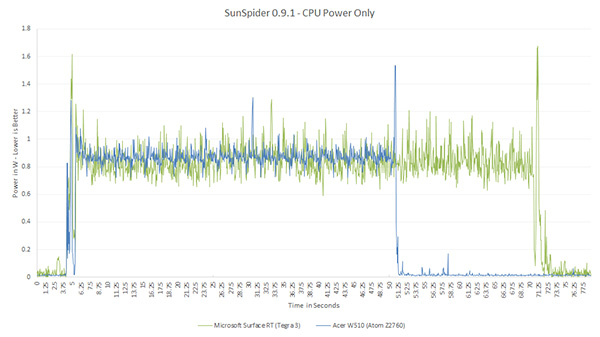

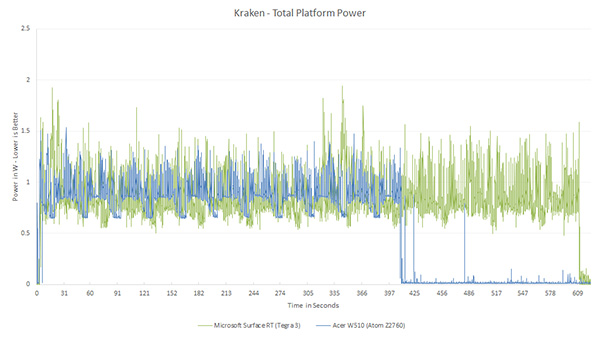
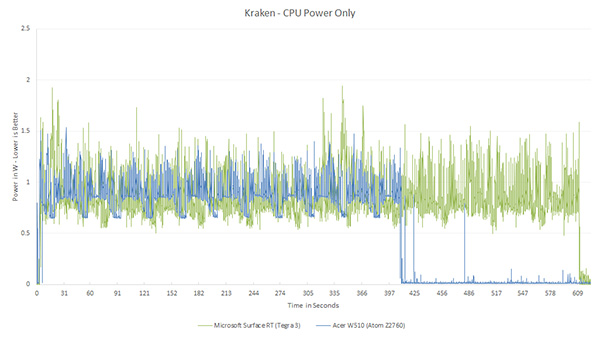

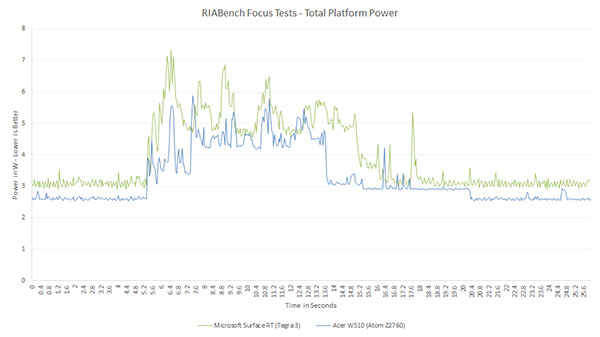
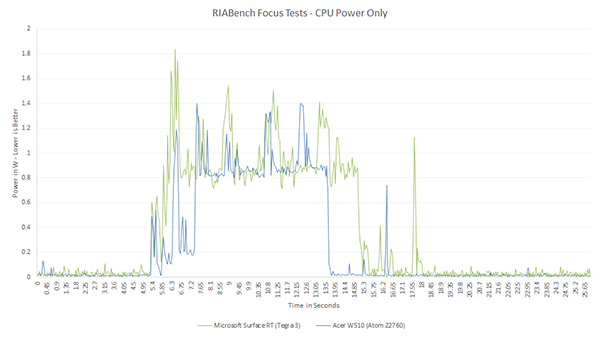
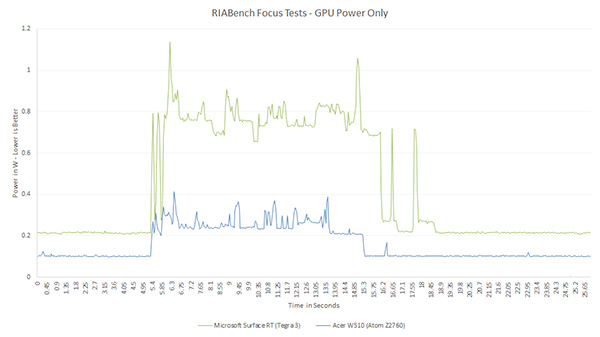








163 Comments
View All Comments
Exodite - Tuesday, December 25, 2012 - link
I think it's probably a fair guess that Apple has planned to converge their mobile and traditional computer business to the same hardware platform for some time.It's just not going to be x86.
wsw1982 - Tuesday, December 25, 2012 - link
However, the fact is the ATOM can emulate the ARM with similar performance, but not the other way around. It will be interesting to see apple fully commit to netbook level performance.StevoLincolnite - Tuesday, December 25, 2012 - link
Software compatibility isn't that big of a deal either as Intel showed us Binary Translation awhile ago allowing Medfield to run x86 and ARM instructions.krumme - Monday, December 24, 2012 - link
I think this just proves Intels business is not tailored for the new low cost mobile market. A9 on low cost 40nm eats Atom for breakfast each and every day on the market -fact- and A15 will do exactly the same on dirt cheap 28nm.tipoo - Monday, December 24, 2012 - link
I think we read different articles. Atom is rather competitive. It is not eaten for breakfast by 40nm ARM parts.yyrkoon - Tuesday, December 25, 2012 - link
depends on how you look at it. Find me an atom based 7" tablet for $200. Such as the Nexus 7 ( which many regard as the best tablet in its class )p3ngwin1 - Tuesday, December 25, 2012 - link
like i said in another comment here, you can get Chinese tablets running Android 4.1 with 1.6Ghz Dual-Core ARM processors with Mali400 GPU's (good enough for many) with 7" 1280x720 screens, etc all for less than $150.the chips are usually Allwinner or Rockchip, etc and the performance is good enough for most people at an incredible price that Intel simply can't match.
There's a reason in the early Netbook days why Intel wouldn't let Atom processors inside anything larger than 10" and 1024x768 screens, etc
It's because Intel didn't want people being happy with Atom performance in larger computers, so if you wanted larger screens, etc you were artificially forced to pay for more processing potential than you needed.
Intel have performance, and lately they're getting the power efficient too, but they are still a premium processor option and that's where ARM still has the advantage.
I don't see Intel willing to drop their prices any time soon to compete with cheap Android tablets. Intel would rather create bullcrap categories like "Ultra-book" (it's still a laptop for Christ-sake !) and convincing people they NEED expensive computers that cost $800+.
Meanwhile other ISA's like ARM and MIPS are lowering the price barrier to products with more than enough processing power and battery-life for most people.
Intel are left to convince people they need a desktop/laptop in a world increasingly going mobile and always-connected
yyrkoon - Tuesday, December 25, 2012 - link
You can even buy ICS tablets for as little as $50 is you keep an eye out.Personally though, I would not settle for anything less than the Nexus 7. Sometimes, peace of mind means more than money.
Point was however, that there is more than just power /watt efficiency to consider here. Especially when enjoying those number comes at a huge price premium.
Along the lines of what Intel can not match price wise. I am fairly confident that Intel can not even match prices with Texas Instruments in most cases. But I also believe that Intel does not need to convince buyers into thinking that desktops, and laptops are still necessary. Mainly because mostly they are( and will continue to be ). At minimum, high performance workstations, and servers will still need to exist for various applications.
I think that x86 and ARM both will continue to be around for a very long time. Which is a good thing.
wsw1982 - Tuesday, December 25, 2012 - link
So Intel cannot make atom cheaper because it don't need to pay TSMC for manufacture, don't need to pay ARM for license,do have mature 32 process than rest of the industry, do have the medfield's die area smaller than both tegra 3 and krait, and do have enough production capabilities idle for nothing.Desktop and server along could make Intel maintain manufacture advantage and R&D spending, how hurt is it to adopting the wasted production capability in produce the mobile chips as bonus? Anyway, the PC market will be still growing according to the all the prediction professionals, and the ATOM is quite safe to reuse the R&D spent on the core processors.
With 100$ you can also got the netbook from Chinese manufactures which, despite the cheap feeling and bad building quality, is as responsive and useful as the netbooks from big companies. But the 80$ android tablet is nearly unusable.
talzara - Thursday, December 27, 2012 - link
You do realize that Texas Instruments has exited the ARM processor business for mobile devices, right? The margins were too thin. They're still making ARMs for embedded devices, but they've given up on mobile.ARM is the classic disruptive innovation. It reduces prices for consumers, and cuts a swathe of destruction through industry margins. There are just too many players in ARM -- they're interchangeable enough that they have a hard time charging any kind of premium for their products.
Nvidia has shipped tens of millions of Tegras, so much so that it now accounts for 20% of Nvidia's revenues. Great business, right? Think again. Tegra accounts for -16% of Nvidia's net income. That's not a typo -- it really is a negative number. Nvidia makes all of its money from GPUs -- gaming GPUs, consumer GPUs, and GPUs sold for massively-parallel computing. (Source: Nvidia 10-Q for Q3 of fiscal 2013 -- segment breakdown at the bottom of page 27.)
So now we've got one major ARM vendor quitting, and another major ARM vendor bleeding cash. The ones that are doing well are the ones that don't actually care about the CPU. Qualcomm is horizontally integrated -- they make money on the LTE chipset. Apple and Samsung are vertically integrated -- they make their money on the whole device, not on the CPU.
In such a crazy market, Intel may well prefer to sell a premium product to 5% of the market, rather than a price-competitive product to 30%.